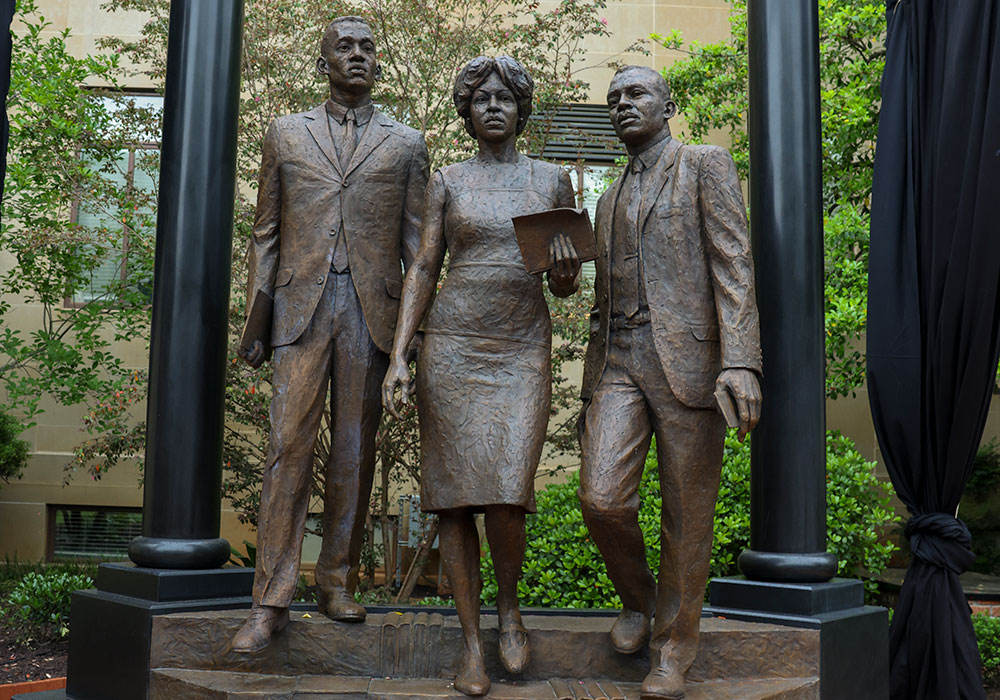The University of South Carolina unveiled a monument Friday (April 19) honoring the first Black students admitted since Reconstruction — Robert Anderson, Henrie Monteith Treadwell and James Solomon Jr. — whose enrollment six decades ago changed the course of university history.
Commissioned by the Board of Trustees, the 12-foot bronze monument now stands near McKissick Museum on the historic Horseshoe. Treadwell, Solomon and representatives from Anderson’s family were joined by Board Chairman Thad Westbrook, USC President Michael Amiridis and other university and civic leaders for the unveiling.
“This inspiring monument, standing tall at the heart of our historic Horseshoe, will bear witness every day to the university’s unwavering promise to provide educational opportunities for all,” said Amiridis. “This is our responsibility to the people of South Carolina.”
In 2022, the university announced the selection of Jamaican-born sculptor Basil Watson, whose past work includes tributes to Martin Luther King Jr. and Rep. John Lewis. Watson’s vision for the statue was inspired by the now-iconic photograph of the three students stepping out of the Osborne Administration building after meeting with university officials on Sept. 11, 1963.
Treadwell, at just 16 years old, filed the lawsuit that led to USC’s integration. She went on to earn a bachelor’s in biochemistry in 1965, becoming the university’s first Black graduate since Reconstruction. Her education didn’t end at USC — she also earned a master’s from Boston University, a Ph.D. from Atlanta University and completed postdoctoral studies at the Harvard University School of Public Health. She has enjoyed a long career in public health and is founding executive director of Community Voices at Morehouse School of Medicine, where she has advanced health care for underserved populations.
Anderson, a political science major and Greenville native, transferred to USC from Clark College. After graduation, he served a combat tour in Vietnam, then became a social worker in New York City, where his public service efforts included helping Cuban refugees and running an alcohol counseling program. He died in 2009.
Solomon was a faculty member at Morris College who transferred into USC’s mathematics department as a graduate student. In addition to his career in higher education, he was elected to the Sumter District 17 School Board and held various administrative positions in South Carolina state government, eventually retiring as commissioner of the Department of Social Services. When ground was broken on the monument in September, Solomon was honored with a plaque in LeConte College, home of the university’s math department.
“It is appropriate that the Board of Trustees led the effort to recognize the bravery and determination of our students who desegregated the university,” said Westbrook. “The Board pays tribute to Dr. Henrie Monteith Treadwell and James L. Solomon Jr. and to the memory of Robert G. Anderson. The Board appreciates the leadership that Chair Emeritus Smith and Trustee English demonstrated in the effort to conceptualize and finalize the desegregation monument. The Board is grateful for the incredible talent of sculptor Basil Watson and for the patient oversight of university architect Derek Gruner."
The monument’s location outside McKissick Museum is significant not only because of its proximity to the Osborne Administration building, but because it is prominently displayed near the university’s Visitor Center. For Treadwell, it will serve as a symbol of the university’s progress to all who come to campus.
“I want them to see a place where all are welcome that has embraced the fact that we are different people,” Treadwell says. “I want them to see in my colleagues, but also in myself as a woman, someone who said, ‘I can do this. This should be done so that you can also come.’ That doesn't mean you as simply African American, but you as a member of society. Everybody is welcome here. And that's really what I want people to think about. This university took a huge step that day, and it is continuing to walk forward.”

What They're Saying
Bobby Donaldson, executive director of the Center for Civil Rights History and Research, associate professor of History
“Basil Watson’s sculpture is a testament to the courage of three pioneers and their families and attorneys who fought for their constitutional right to take the monumental steps they took in 1963. Mr. Watson’s installation transforms the landscape of the Horseshoe — the most iconic space on our campus. It now stands as a moving reminder of the enduring struggle for freedom and justice.”
Alex English, Board of Trustees member
“The desegregation of the University of South Carolina on Sept. 11, 1963, is one of the most important days in the history of this institution. It’s necessary that the university celebrates its desegregation in a way that future generations will appreciate.”
Dr. C. Dorn Smith III, Board of Trustees chair emeritus
“It was essential that the Board of Trustees take the lead in commemorating USC’s desegregation. Basil Watson has sculpted a beautiful, majestic monument that all visitors to USC will appreciate while appreciating the importance of desegregation itself.”
Basil Watson, sculptor
“It has been a long journey but a gratifying one that gives a sense of pride, knowing that my contribution will be a lasting monument to the building of a legacy that represents values of equality and justice.”
Julian Williams, vice president of access and opportunity
“Robert Anderson, Henrie Montieth Treadwell and James Solomon Jr. are an important part of the university’s past, present and future. Through their courage and sacrifice to challenge the status quo of their time, they helped pave the way for the University of South Carolina to grow into the diverse campus we experience today. This monument will serve as a reminder of how far we’ve come as an institution and as a place for future generations to reflect on the legacies of these three pioneers.”
